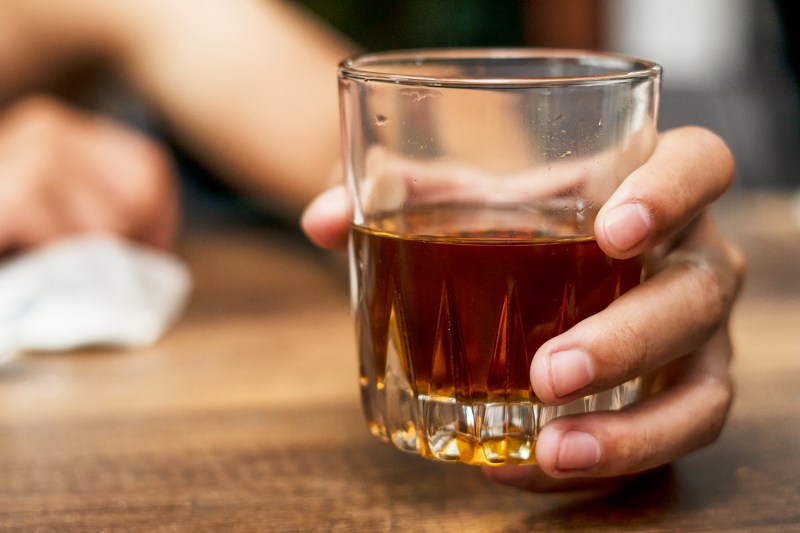The cocktail renaissance has seen its fair share of ups and downs and ebbs and flows, as bartenders and drinkers veer from complicated ten-ingredient concoctions to simple classics and back again. But there are still certain historical drinks that have yet to be truly revisited, for one reason or another. Sometimes they are unsavory mixtures best left to the annals of time, other times they are forgotten gems waiting for their moment to be dusted off and shine again. One example of a currently overlooked cocktail is the Stinger, although it depends on who you are talking to as to whether it belongs in the former or latter category.
At first glance, the Stinger is a weird drink, and one that by today’s standards doesn’t sound immediately appealing. The Mr. Boston recipe (which is representative of the drink’s 1960s and ’70s heyday) combines 0.5 ounces white creme de menthe and 1.5 ounces brandy that you shake with ice and strain into a coupe glass. You read that right — creme de menthe and brandy. Think saccharine, artificially sweetened, mint-flavored liqueur from a cheap DeKuyper bottle combined with the sweet and slightly spicy notes of a cognac or California brandy, and decide for yourself if that’s really something you’d like to try. At first glance, it’s not exactly as appealing a combination as rye and sweet vermouth, bourbon and bitters, or tequila and triple sec.

According to David Wondrich, author, cocktail historian, and contributor to The Daily Beast’s Half Full column and Life Behind Bars podcast, the Stinger arose from a “low-key craze” for creme de menthe, which was introduced here in the U.S. around 1890. Wondrich says there were other drinks that mixed creme de menthe and cognac throughout that decade, but it wasn’t until about 1900 that the Stinger name came about. “A ‘stinger’ was what we would call a ‘jab,'” he said, “a short, quick punch to the head.” Wondrich notes a few other peculiarities about the Stinger: “It has always been shaken, although it has no juice or eggs (such drinks are usually stirred), and for a long time it wasn’t considered a cocktail, because it had no bitters. It would be listed under miscellaneous
The Stinger has not exactly come back into fashion in the way that, in recent years, other classic cocktails have, including the Aviation or Martinez. “It’s definitely not the most popular cocktail here,” said Edward Creel, director of beverage at Loews Regency New York Hotel, noting he’s only seen a handful of them served at the bar. “It’s a strong drink that survived Prohibition. During that era, many cocktails were made to mask the bad booze that was in circulation — which this cocktail can definitely hold up to. It’s been said that the cocktail was popular amongst airmen during World War II, likely for the same masking principle.”
At New York City’s new The Tavern by WS, bar manager Mark Drew relays a similar lack of customer interest in the Stinger. “I’ve only made a couple of these drinks in the last two decades of being in the industry,” he said. “One for an older gentlemen served at the bar of the Four Seasons, the other for a sommelier researching classic cocktails for an upcoming exam.” Drew attributes the Stinger’s demise to two main reasons: The decline of liqueur-driven
If you are interested in making a Stinger for yourself at home, the experts have some advice. Wondrich recommends never exceeding one part creme de menthe to three parts brandy, and suggests using VSOP cognac or better. Creel hues pretty closely to the classic recipe: 2.5 ounces brandy and .5 ounce crème de menthe white, stirred over ice, strained into a chilled cocktail glass. Drew’s version might be difficult to make at home, and he suggests a modern take using a 3:1 ratio of dry style
These are extremely trying times, but once things get back to normal for us all please patronize your local bar — and maybe even order a Stinger.
Editors' Recommendations
- The 12 Best Valentine’s Day Cocktail Recipes to Make
- Why the Michelada Should Be Your New Favorite Brunch Drink
- Would You Pay $350 for a ‘Cocktail Pod’ Machine that Dispenses Mixed Drinks?
- How to Make the Controversial Singapore Sling Cocktail
- 8 Grilled Cocktails To Enjoy This Labor Day Weekend




